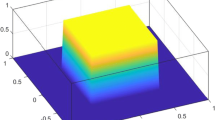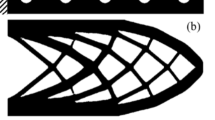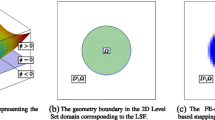Abstract
The aim of this research is to construct a shape optimization method based on the convected level set method, in which the level set function is defined as a truncated smooth function obtained by using a sinus filter based on a hyperbolic tangent function. The local property of the hyperbolic tangent function dramatically reduces the generation of red the error between the specified profile of the hyperbolic tangent function and the level set function that is updated using a time evolution equation. In addition, the small size of the error facilitates the use of convective reinitialization, whose basic idea is that the reinitialization is embedded in the time evolution equation, whereas such treatment is typically conducted in a separate calculation in conventional level set methods. The convected level set method can completely avoid the need for additional calculations when performing reinitialization. The validity and effectiveness of our presented method are tested with a mean compliance minimization problem and a problem for the design of a compliant mechanism.

















Similar content being viewed by others
References
Allaire G, Jouve F (2008) Minimum stress optimal design with the level set method. Engrg Anal Bound Elem 32(11):909–918
Allaire G, Jouve F, Toader A (2004) Structural optimization using sensitivity analysis and a level-set method. J Comput Phys 194(1):363–393
Allaire G, De Gournay F, Jouve F, Toader A (2005) Structural optimization using topological and shape sensitivity via a level set method. Control Cybern 34(1):59–80
Allaire G, Dapogny C, Frey P (2014) Shape optimization with a level set based mesh evolution method. Comput Methods Appl Mech Eng 282:22–53
Allen S M, Cahn J W (1979) A microscopic theory for antiphase boundary motion and its application to antiphase domain coarsening. Acta Metall 27(6):1085–1095
Amstutz S, Andrä H (2006) A new algorithm for topology optimization using a level-set method. J Comput Phys 216(2):573–588
Bendsøe MP Kikuchi N (1988) Generating optimal topologies in structural design using a homogenization method. Comput Methods Appl Mech Eng 71(2):197–224
Cahn J W, Hilliard J E (1958) Free energy of a nonuniform system. I. Interfacial free energy. Chin J Chem Phys 28(2):258–267
Castro-Diaz M, Hecht F, Mohammadi B, Pironneau O (1997) Anisotropic unstructured mesh adaption for flow simulations. Int J Numer Methods Fluids 25(4):475–491
Challis V J, Guest J K (2009) Level set topology optimization of fluids in Stokes flow. Int J Numer Methods Engng 79(10):1284– 1308
Coupez T, Silva L, Hachem E (2015) Implicit boundary and adaptive anisotropic meshing. In: Perotto S, Formaggia L (eds) New challenges in grid generation and adaptivity for scientific computing, SEMA SIMAI springer series, vol 5, springer international publishing, pp 1–18
Desjardins O, Moureau V, Pitsch H (2008) An accurate conservative level set/ghost fluid method for simulating turbulent atomization. J Comput Phys 227(18):8395–8416
Duan X B, Ma Y C, Zhang R (2008) Shape-topology optimization for Navier–Stokes problem using variational level set method. J Comput Appl Math 222(2):487–499
Eschenauer H A, Kobelev V V, Schumacher A (1994) Bubble method for topology and shape optimization of structures. Struct Optimiz 8(1):42–51
Guo X, Zhang W, Zhong W (2014) Doing topology optimization explicitly and geometrically—a new moving morphable components based framework. J Appl Mech 81(8):081,009
Hecht F (2012) New development in freefem++. J Numer Math 20(3-4):251–266
Khalil H, Bila S, Aubourg M, Baillargeat D, Verdeyme S, Jouve F, Delage C, Chartier T (2010) Shape optimized design of microwave dielectric resonators by level-set and topology gradient methods. Int J RF Microw Comput-Aided Eng 20(1):33–41
Luo Z, Tong L (2008) A level set method for shape and topology optimization of large-displacement compliant mechanisms. Int J Numer Methods Engng 76(6):862–892
Luo Z, Tong L, Luo J, Wei P, Wang M Y (2009) Design of piezoelectric actuators using a multiphase level set method of piecewise constants. J Comput Phys 228(7):2643–2659
Nishiwaki S, Frecker M I, Min S, Kikuchi N (1998) Topology optimization of compliant mechanisms using the homogenization method. Int J Numer Methods Engng 42:535–559
Nishiwaki S, Min S, Yoo J, Kikuchi N (2001) Optimal structural design considering flexibility. Comput Methods Appl Mech Eng 190(34):4457–4504
Olsson E, Kreiss G (2005) A conservative level set method for two phase flow. J Comput Phys 210(1):225–246
Olsson E, Kreiss G, Zahedi S (2007) A conservative level set method for two phase flow II. J Comput Phys 225(1):785– 807
Osher S, Sethian J A (1988) Fronts propagating with curvature-dependent speed: Algorithms based on Hamilton-Jacobi formulations. J Comput Phys 79(1):12–49
Park K S, Youn S K (2008) Topology optimization of shell structures using adaptive inner-front (AIF) level set method. Struct Multidiscip Optim 36(1):43–58
Pironneau O (1982) On the transport-diffusion algorithm and its applications to the Navier-Stokes equations. Numer Math 38(3):309–332
Pironneau O (1984) Optimal shape design for elliptic systems. Springer, Berlin
Sethian J A, Wiegmann A (2000) Structural boundary design via level set and immersed interface methods. J Comput Phys 163(2):489–528
Sigmund O (1997) On the design of compliant mechanisms using topology optimization. Mech Based Des Struct Mechines 25(4):493–524
Sigmund O, Maute K (2013) Topology optimization approaches. Struct Multidiscip Optim 48(6):1031–1055
Sokolowski J, Zochowski A (1999) On the topological derivative in shape optimization. SIAM J Control Optim 37(4):1251–1272
Sokolowski J, Zolesio J P (1992) Introduction to shape optimization. Springer, Berlin
Strain J (1999) Semi-lagrangian methods for level set equations. J Comput Phys 151(2):498–533
Van Dijk N P, Maute K, Langelaar M, Van Keulen F (2013) Level-set methods for structural topology optimization: a review. Struct Multidisc Optim 48(3):437–472
Ville L, Silva L, Coupez T (2011) Convected level set method for the numerical simulation of fluid buckling. Int J Numer Methods Fluids 66(3):324–344
Wang M Y, Wang X (2004) Color level sets: a multi-phase method for structural topology optimization with multiple materials. Comput Methods Appl Mech Eng 193(6):469–496
Wang M Y, Wang X, Guo D (2003) A level set method for structural topology optimization. Comput Methods Appl Mech Eng 192(1):227–246
Wang S, Wang M Y (2006) Radial basis functions and level set method for structural topology optimization. Int J Numer Methods Engng 65(12):2060–2090
Wei P, Wang M Y (2009) Piecewise constant level set method for structural topology optimization. Int J Numer Methods Engng 78(4):379–402
Yamada T, Izui K, Nishiwaki S, Takezawa A (2010) A topology optimization method based on the level set method incorporating a fictitious interface energy. Comput Methods Appl Mech Eng 199(45-48):2876–2891
Zhou S, Li W, Sun G, Li Q (2010) A level-set procedure for the design of electromagnetic metamaterials. Opt Express 18(7):6693–6702
Zhu B, Zhang X, Fatikow S (2015) Structural topology and shape optimization using a level set method with distance-suppression scheme. Comput Methods Appl Mech Eng 283:1214–1239
Acknowledgments
The authors would like to express their gratitude to Prof. Frédéric Hecht, Prof. François Jouve, and Prof. Thierry Coupez for their helpful discussion of this work. The first author was able to conduct overseas research in France supported by JSPS KAKENHI, Grant-in-Aid for JSPS Fellows, 14J02008.
Author information
Authors and Affiliations
Corresponding author
Appendix A Update scheme for the level set function based on the method of characteristics
Appendix A Update scheme for the level set function based on the method of characteristics
Here, we discuss the basic idea of the method of characteristics and its application to solve the time evolution equation in (20).
For this brief explanation, we first deal with the simple advection equation (15). Consider a vector field X that satisfies the following ordinary differential equation,
The time derivative of the composite function ψ∘X(t) = ψ(X(t),t) is obtained as follows:
where Dψ/Dt represents the material derivative of ψ and corresponds to the left-hand side of (15). Based on the backward Euler scheme and using a time step Δt, this can be discretized as
We now assume that the discrete time is defined as 0<t 1<⋯<t n <⋯<t N with t n = nΔt, and consider the following initial value problem:
Using an approximate solution, X n(x): = x−V(x,t n )Δt, we obtain the following relation:
Consequently, (A.3) can be reformulated as
Using a test function \(\tilde {\psi }\), the notation ψ n: = ψ(⋅,t n ), and the scalar product (⋅,⋅) in L 2(D), the material derivative of ψ n can be approximated as follows:
where ψ and \(\tilde {\psi }\) are chosen from a finite element space. Due to the definition of V = v n with n=∇ψ/|∇ψ|, it should be noted that we need to assume that V(x,t n )≈V(ψ n−1), to avoid the nonlinearity in (A.7).
Equation (A.7) can be only used for solving (15), so it must be expanded in order to solve (20) in which the convection velocity is defined as (V−λsign(ψ)n) instead of only V as it is in (15). Considering the source term λsign(ψ)G(ψ), (20) can be approximated as
where X n = x−(V(x,t n )−λsign(ψ n−1)n)Δt. Note that the use of sign(ψ n−1) and G(ψ n−1) in the right-hand side of (A.8) is necessary to avoid the nonlinearity.
Rights and permissions
About this article
Cite this article
Yaji, K., Otomori, M., Yamada, T. et al. Shape and topology optimization based on the convected level set method. Struct Multidisc Optim 54, 659–672 (2016). https://doi.org/10.1007/s00158-016-1444-z
Received:
Revised:
Accepted:
Published:
Issue Date:
DOI: https://doi.org/10.1007/s00158-016-1444-z




